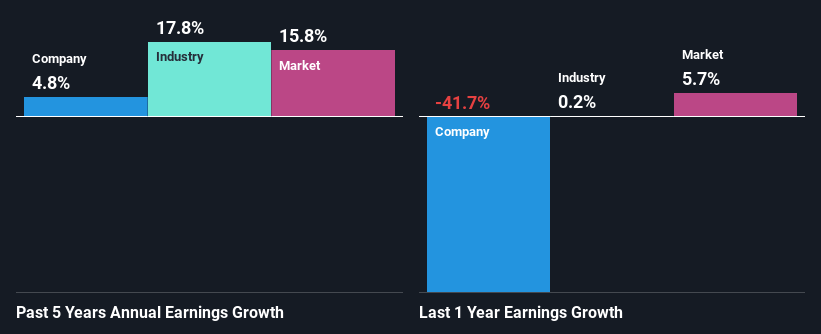FedEx Corporation's (NYSE:FDX) Stock On An Uptrend: Could Fundamentals Be Driving The Momentum?
FedEx's (NYSE:FDX) stock is up by a considerable 10% over the past three months. As most would know, fundamentals are what usually guide market price movements over the long-term, so we decided to look at the company's key financial indicators today to determine if they have any role to play in the recent price movement. In this article, we decided to focus on FedEx's ROE.
Return on equity or ROE is an important factor to be considered by a shareholder because it tells them how effectively their capital is being reinvested. Put another way, it reveals the company's success at turning shareholder investments into profits.
See our latest analysis for FedEx
How Do You Calculate Return On Equity?
The formula for return on equity is:
Return on Equity = Net Profit (from continuing operations) ÷ Shareholders' Equity
So, based on the above formula, the ROE for FedEx is:
12% = US$3.0b ÷ US$25b (Based on the trailing twelve months to February 2023).
The 'return' is the yearly profit. So, this means that for every $1 of its shareholder's investments, the company generates a profit of $0.12.
What Has ROE Got To Do With Earnings Growth?
So far, we've learned that ROE is a measure of a company's profitability. Based on how much of its profits the company chooses to reinvest or "retain", we are then able to evaluate a company's future ability to generate profits. Assuming all else is equal, companies that have both a higher return on equity and higher profit retention are usually the ones that have a higher growth rate when compared to companies that don't have the same features.
FedEx's Earnings Growth And 12% ROE
To start with, FedEx's ROE looks acceptable. Even so, when compared with the average industry ROE of 15%, we aren't very excited. Additionally, the low net income growth of 4.8% seen by FedEx over the past five years doesn't paint a very bright picture. Bear in mind, the company does have a respectable level of ROE. It is just that the industry ROE is higher. Hence there might be some other aspects that are keeping growth in earnings low. Such as, the company pays out a huge portion of its earnings as dividends, or is facing competitive pressures.
As a next step, we compared FedEx's net income growth with the industry and were disappointed to see that the company's growth is lower than the industry average growth of 18% in the same period.
The basis for attaching value to a company is, to a great extent, tied to its earnings growth. It’s important for an investor to know whether the market has priced in the company's expected earnings growth (or decline). By doing so, they will have an idea if the stock is headed into clear blue waters or if swampy waters await. Is FedEx fairly valued compared to other companies? These 3 valuation measures might help you decide.
Is FedEx Making Efficient Use Of Its Profits?
FedEx's low three-year median payout ratio of 23% (or a retention ratio of 77%) should mean that the company is retaining most of its earnings to fuel its growth. However, the low earnings growth number doesn't reflect this fact. So there might be other factors at play here which could potentially be hampering growth. For example, the business has faced some headwinds.
Moreover, FedEx has been paying dividends for at least ten years or more suggesting that management must have perceived that the shareholders prefer dividends over earnings growth. Based on the latest analysts' estimates, we found that the company's future payout ratio over the next three years is expected to hold steady at 24%. However, FedEx's ROE is predicted to rise to 18% despite there being no anticipated change in its payout ratio.
Conclusion
Overall, we feel that FedEx certainly does have some positive factors to consider. Yet, the low earnings growth is a bit concerning, especially given that the company has a respectable rate of return and is reinvesting a huge portion of its profits. By the looks of it, there could be some other factors, not necessarily in control of the business, that's preventing growth. With that said, the latest industry analyst forecasts reveal that the company's earnings are expected to accelerate. To know more about the latest analysts predictions for the company, check out this visualization of analyst forecasts for the company.
Have feedback on this article? Concerned about the content? Get in touch with us directly. Alternatively, email editorial-team (at) simplywallst.com.
This article by Simply Wall St is general in nature. We provide commentary based on historical data and analyst forecasts only using an unbiased methodology and our articles are not intended to be financial advice. It does not constitute a recommendation to buy or sell any stock, and does not take account of your objectives, or your financial situation. We aim to bring you long-term focused analysis driven by fundamental data. Note that our analysis may not factor in the latest price-sensitive company announcements or qualitative material. Simply Wall St has no position in any stocks mentioned.
Join A Paid User Research Session
You’ll receive a US$30 Amazon Gift card for 1 hour of your time while helping us build better investing tools for the individual investors like yourself. Sign up here

 Yahoo Finance
Yahoo Finance 
